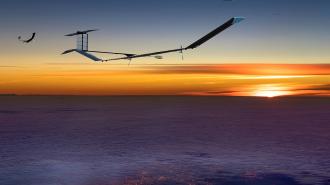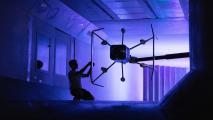The US Army has been flying a skeletal solar-powered drone for more than 40 days straight — breaking a world record and foreshadowing the future of military surveillance.
The challenge: Intelligence, surveillance, and reconnaissance (ISR) systems, such as satellites and drones, play a major role in defense by gathering information the military can then use to plan its operations — but they have their limitations.
Zephyr delivers the benefits of ISR satellites and traditional drones without many of their limitations.
While satellites can remain operational for long periods of time, they are expensive to launch and difficult to maneuver. It can also take days for the data they collect to be transmitted to Earth — time soldiers might not have on the battlefield.
Drones are cheaper than satellites and can provide data in real-time, but they typically run out of fuel or battery power after a few hours or days, and they can be downed by inclement weather or anti-aircraft weapons.
A stratospheric drone: The US Army is currently testing Zephyr, a solar-powered drone built by Airbus that delivers the benefits of ISR satellites and traditional drones without many of their limitations.
The remote-operated aircraft flies in the stratosphere, meaning it’s above the weather conditions that might ground a traditional drone. The location is also high enough for Zephyr to survey a wide area of land, but close enough to Earth’s surface that it can deliver data in near-real time.
The solar-powered drone is hand-launched from a runway — no need to pay for a rocket — and despite having a wingspan of 82 feet, it weighs just 165 pounds.
That lightweight design means it can stay in the air using about as much electricity as a commercial light bulb, which is provided by the solar panels covering almost every inch of the aircraft’s surface and onboard batteries.

The most impressive thing about Zephyr, though, is its endurance.
In 2018, one of the aircraft flew for nearly 26 days straight, and a Zephyr the Army launched on June 15, 2022, was still flying as of July 29, setting a new world record for long-endurance flight while amusing followers with its flight patterns.
There’s no word on when that Zephyr will land, but the Army said on July 21 that it planned to launch another one “in the coming weeks” as part of its continued testing of the aircraft.
Civilian cells: While the Army appears keen to add Zephyr to its ISR arsenal, potential applications for the ultralight solar-powered drone go beyond the military.
In 2021, Airbus and Japanese mobile phone operator NTT Docomo conducted a trial demonstrating how Zephyrs could deliver wireless broadband connectivity to people on the ground — helping close the digital divide.
“Billions of people across the world suffer from poor or no connectivity,” said Stephane Ginoux, head of North Asia region for Airbus. “These tests show us the viability of the stratosphere to bridge this divide and provide direct to device connectivity via Zephyr without the need for base stations or extra infrastructure.”
We’d love to hear from you! If you have a comment about this article or if you have a tip for a future Freethink story, please email us at [email protected].






